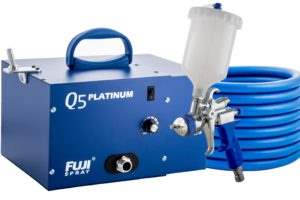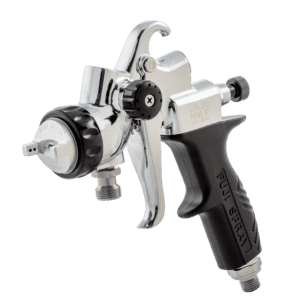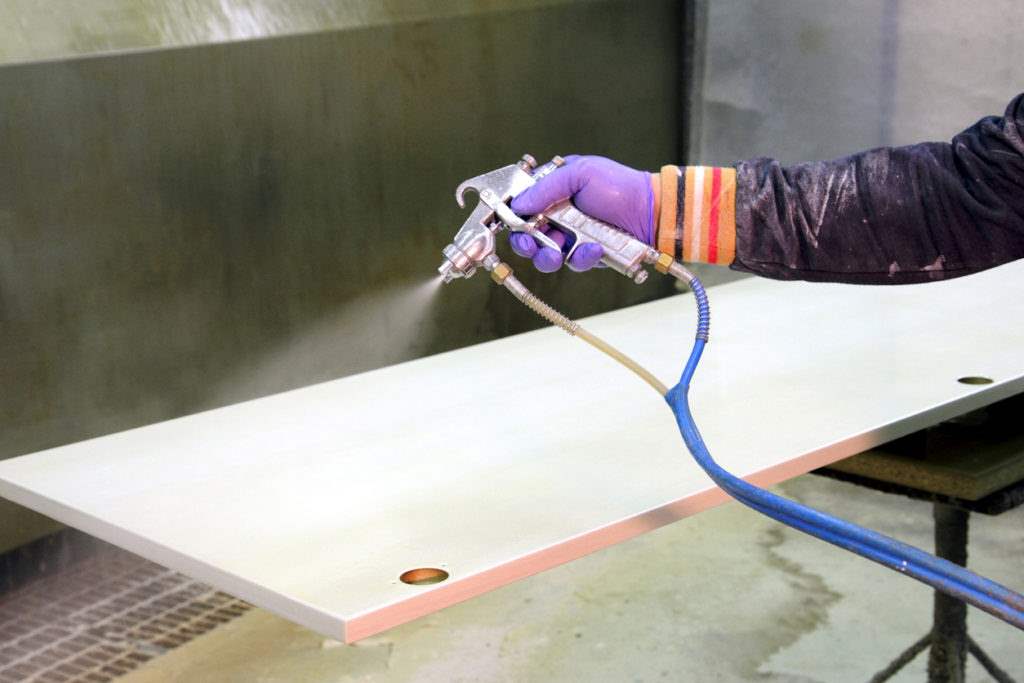If you’re a regular reader, you know I dispense advice based on the frequency of the questions being asked.
Notes from the Emtech Lab has covered a lot of ground over the past six months, but we have not touched on perhaps the most important topic yet – what type of spray equipment to use to get the best results when using a water based wood finish.
There are a lot of facts — and a whole bunch of fallacies — floating around the Web about water based finishes and what type of spray equipment to use.
So, let’s clear the air on a few of more popular questions and misconceptions.
Question #1: Which type of spray gun is best for water based wood finishes; one that uses compressed air or turbine air?
Answer: Both types of air delivery systems are excellent choices; you just need to think about where and how you will be using them…and what is the best value for the dollar spent.
Using compressed air provides versatility. One compressor can power a wide array of shop tools and can be used to operate an air-assisted-airless or airless spray pump.
A turbine will only drive a single spray gun, but turbine driven air offers clean, warm air generated by a very light, portable unit. New designs offer adjustments in the CFM (cubic feet/minute), too, giving a bit more control over the atomization process. These factors, coupled with the quality of modern turbine-driven “high volume, low pressure” (HVLP) spray guns makes for a very functional option.

Other key differences: turbine guns atomize coatings at lower pressures, resulting in vastly improved fluid transfer efficiency with greatly reduced over spray. Compressed air requires a bit more thought into what tank size to use and how to filter the air (for potential water, oil and dirt) prior to final delivery. As a professional finisher, I use both air delivery options on a regular basis.
Question #2: Do water based finishes require stainless steel gun passages?
Answer: No. There is a fallacy floating around that if you do not have stainless steel passages in the spray gun when using a water based finish you will ruin the gun. Let’s shed some light on this.
If you are fortunate to have a very old spray gun in good working condition, it probably has brass, or a combination of brass and stainless components, in the fluid and air passage.
Back in the old days when using a hot solvent finish such as nitrocellulose was the norm, the solvent performed a type of flash cleaning of the fluid passage and tip set as it ran through the gun – it was almost like a self-cleaning process.
In fact, a finisher could even use the spray gun as a storage vessel – fill it with nitro and hang up the gun for the night.
But not anymore! Waterborne finishes and brass tend to react when exposed to one another over a long period of time. And because today’s higher-solids, water based formulas have less volatile solvents, the tip set can become clogged.
Bottom line: your spray gun is not a storage vessel! It is not intended to be filled with a water based finish and then hung on a hook to be left unused for days on end.
So, whether you have and older brass passage gun, combo brass/stainless, or an all-stainless one, you need to flush the gun with a solution of water and alcohol after each use.
The good news is, you do not have to ditch your older gun, which brings us to Question #3…
Question #3: If I’ve been using solvent-based finishes, do I need to buy a new pressure pot, hoses and spray gun specifically for water based finishes?
Answer: No, unless you really want to. What you should focus on is using new pot liners in your pressure pot, replacing the fluid hose assembly with a clean, new fluid hose, and buying the right size needle/nozzle/air cap set for the type and viscosity of the water based finish you will be using. Using too small of a tip/nozzle set will choke your fluid volume. Solvent in the old fluid hose will contaminate your water-based coating, and, finally, don’t be penny wise and pound foolish – replace your pot liners on a regular basis!
Question #4: Are HVLP spray guns only for turbine use?
Answer: No. HVLP spray guns are available in both turbine and compressed air configurations. The air delivery method is secondary to the CFM volume required to atomize the coating at lower pressures. It all boils down to the design of the air passages and atomization cap. How the air gets to t

he gun, be it forced by a turbine or via compression, is only part of the HVLP equation.
Question #5: Should I use Airless spray or Air-Assisted Airless spray with water-based finishes?
Answer: You can use either if you have the correct fluid and fan pattern tip selected for the gun being used. Air-Assisted Airless (AAA) is more forgiving and offers the best in fluid and atomization control. For long run/production use nothing beats a well configured AAA unit. They are fast, efficient and they are not air hogs.
Airless units also have their place in the world of spraying water-based finishes, especially pigmented finishes. Due to the very high rate of fluid transfer via hydraulic pressure, these units are FAST, and you really must know your hand/eye abilities to apply a thin wet film without the airless unit getting ahead of you. Even with a fine-finish tip in the gun, you really have to hustle when working with an airless unit.
I hope the above tips help you choose and use the best spray gun and related equipment for your water-based wood finishes.
Have any questions or tips of your own? Please share your thoughts or read what others are saying in the comments section below.



Two additional suggestions…
A gravity feed gun (cup on the top) has a much shorter paint path, so is easier to clean, and can normally use most or all of the “fill” while a cup below cannot (in my experience) conveniently use the last several ounces left in the cup. When I bought my last two turbine guns, there was not an option for gravity feed, as I had been using with my air compressor.
If you are not in a production shop, a remote paint pot is not only lots more paint path to clean, but is a challenge keeping the “grunge” mixed, where grunge is my technical name for the material that creates the satin/semi-gloss, etc. finish in what would otherwise be a gloss finish. I sold my separate paint pot decades ago.
Thank you, Charlie! Your comment is well received.
-JW-
Thanks for information and opinions.
I’ve been spraying target finishes with a LVLP setup for a couple years now and getting incredible control. A small detail gun with a 1.0 or 1.4 tip running at 11-15 PSI allows me to lay on nice thin fast drying coats with little overspray. This is especially useful when spraying clear coats on intricate carvings where all the nooks and crannies will puddle up finish and make a mess real fast if the coats go on too thick. I use the same system when refinishing kitchen cabinet cases with pigmented finishes and almost never get a run or sag.
Paul –
Thank you for sharing your gun set up information with us. What tip size do you use when spraying pigmented finishes?
-JW-
For pigmented finishes I use 1.4 tip and thin the finish 10% with water. This results in a nice balance of thin fast drying coat, and enough build to flow out level.
Paul — What type and brand of spray gun are you using?
-JW-
I can’t get rid of the the bubbles with my compressed air Devilbiss, I had to invest in a Graco airless which puts out to much product even with their .008 FF tips
John-
What tip and cap size are you using in your Devilbiss gun, and at what pressures? Also, what type of fluid path does it have, i.e. a gravity cup or a pressure cup?
-JW-
I have the DeVilbiss FLG671 gun, it features a 13 cfm air cap and I’ve tried everything from 1.3, 1.5 and 1.8 tips with little improvement on the bubble issue. i have set the pressure to the recommended 23 psi but have also tried other pressure settings with no significant improvement.
Which finish are your attempting to apply with this specific gun?
I recently acquired the Fuji MPX-30 Gravity Fed Spray Gun. Initially I used the 1.4 needle then switched to the 1.0. Fuji recommended 36 CFM which for me, uses lots of product but wasn’t giving me the desired result. I began playing with different settings and found that Paul’s 11-15 PSI lays a nice pattern.
Harry – Thank you for sharing your observations with us. Which Emtech finish are you spraying with your current gun configuration?
-JW-
Paul, Please share what type of LVLP gun you are using. Thank you!
Anyone have a tip size they like to use with a 4 stage or higher hvlp turbine?
Jerry — It depends on which Emtech product you are using and the viscosity of the coating (non-Emtech). You can find the recommend tip set sizes on the product TDS, found here.